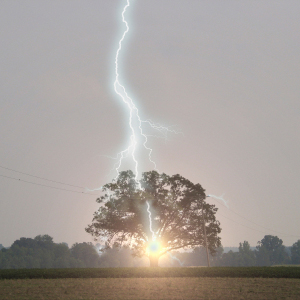
Lightning Protection
Trees are frequent conductors of lightning to the ground. Since sap is a poor conductor, its electrical resistance causes it to be heated explosively into steam, which blows off the bark outside the lightning’s path. In following seasons trees overgrow the damaged area and may cover it completely, leaving only a vertical scar. If the damage is severe, the tree may not be able to recover, and decay sets in, eventually killing the tree.
The two most frequently struck tree types are the oak and the elm. Pine trees are also quite often hit by lightning. Unlike the oak, which has a relatively shallow root structure, pine trees have a deep central root system that goes down into the water table. Pine trees usually stand taller than other species, which also makes them a likely target. Factors which lead to its being targeted are a high resin content, loftiness, and its needles which lend themselves to a high electrical discharge during a thunderstorm.
Trees are natural lightning conductors and are known to provide protection against lightning damages to the nearby buildings. Tall trees with high biomass for the root system provide good lightning protection.

A lightning protection system is a system designed to protect a tree from damage due to lightning strikes by intercepting such strikes and safely passing their extremely high voltage currents to “ground”. Most lightning protection systems include a network of lightning rods, metal conductors, and ground electrodes designed to provide a low resistance path to ground for potential strikes.

